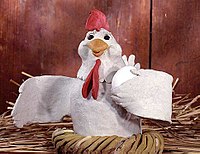Claymation
The term "Claymation" is a registered trademark created by Will Vinton Studios to describe their clay animated movies; the more generic term is "clay animation", but "claymation" has entered the English language as a genericized trademark. Clay animation is but one form of stop motion animation; specifically, it is the form where each animated piece, either character or background, is "deformable".
All animation is produced in a similar fashion, whether done through traditional cel animation, stop-motion, or CGI. Each frame, or still picture, is recorded on film or digital media and then played back in rapid succession. When played back at a frame rate greater than 16 frames per second, a fairly convincing illusion of continuous motion is achieved.

Technical explanation
In clay animation, each object is sculpted in clay or a similarly pliable material such as Plasticine, usually around an armature. As in other forms of object animation, the object is arranged on the set, a shot is taken and the object or character is then moved very slightly by hand. Another shot is taken and the object moved slightly again. To achieve the best results, a consistent shooting environment is needed to maintain the illusion of continuity. This means paying special attention to maintaining consistent lighting and object placement.
Intensity
Producing a stop motion animation using clay is extremely laborious. Normal film runs at 24 frames per second. With the standard practice of "doubles" (double-framing — exposing 2 frames for each shot), 12 changes are usually made for one second of film. For a 30-minute movie, there would be approximately 21,600 stops to change the figures for the frames. For a full length (90 min) movie, there would be approximately 64,800 stops, and possibly far more if parts were shot with "singles" or "ones" (one frame exposed for each shot). Great care must be taken to ensure the object is not altered by accident, by even slight smudges or dirt. For feature-length productions, the use of clay has generally been supplanted by silicone and resin-cast components. However, clay remains a viable animation material where a particular aesthetic is desired.
Some of the best known clay animated works include the Gumby series of television shows created by Art Clokey and the advertisements made for the California Raisin Advisory Board by Will Vinton. However, clay animation has also been used in Academy Award winning short films such as Closed Mondays (1974), The Sand Castle (1977), Creature Comforts (1989), Mona Lisa Descending a Stairase (1992), Wallace & Gromit: A Grand Day Out (1989), Wallace & Gromit: The Wrong Trousers (1993) and Wallace & Gromit: A Close Shave (1995). Creature Comforts and the Wallace & Gromit short films were created by Nick Park of Aardman Animations. Also, the Presentators showed on Nicktoons, was also made by Aardman Animations.
Other films or television shows produced with clay animation
- Martin the Cobbler (Will Vinton, 1976)
- Morph (Peter Lord and Dave Sproxton, 1976)
- Rip Van Winkle (Will Vinton, 1978)
- The Little Prince (Will Vinton, 1979)
- Baby Snakes (Frank Zappa, 1979)
- Creation (Will Vinton and Joan Gratz, 1981)
- The Adventures of Mark Twain (Will Vinton, 1985)(also known as Comet Quest)
- Return to Oz (Will Vinton, 1985)(Knome King scenes)
- A Claymation Christmas Celebration (Joan Gratz, 1987)
- Tim Burton's The Nightmare Before Christmas (Henry Selick, 1994)
- Rex the Runt (Television series, Richard Goleszowski, 1998 UK)
- Chicken Run (Nick Park, 2000)
- Gary and Mike (Television series, 2001)
- Wallace & Gromit: The Curse of the Were-Rabbit (Nick Park, 2005)
- Corpse Bride (Tim Burton, 2005)
Several computer games have also been produced using clay animation, including The Neverhood and Platypus Game.
See also
- Stop Motion
- Art Clokey and Gumby
- Nick Park and Wallace and Gromit
- Will Vinton
- The Neverhood
- Tim Burton
- Celebrity Deathmatch
- Knox (animator)
External links
- Animating a clay chicken
- Technology School of the Future Clay animation page
- TheClayMan.com, Paul Moldovanos creates clay characters and animates them
